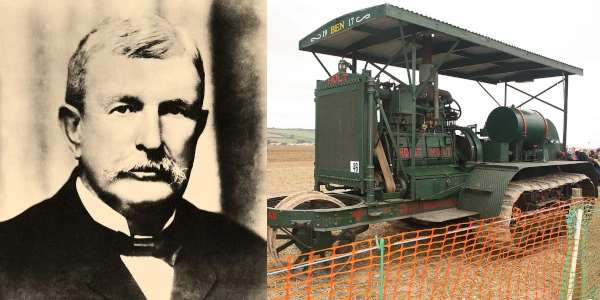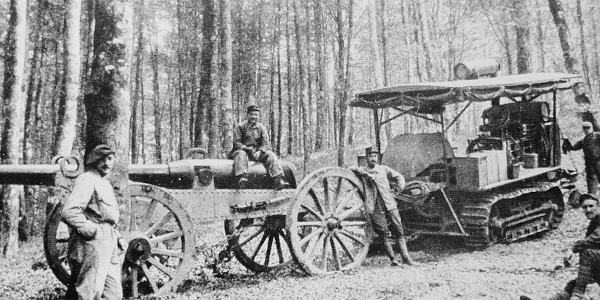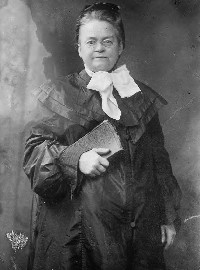Sponsor this page. Your banner or text ad can fill the space above.
Click here to Sponsor the page and how to reserve your ad.
-
Timeline
1904 - Detail
November 24, 1904 - The first successful field tractor is invented by American Benjamin Holt, using a caterpillar track to spread the weight in heavy agricultural machinery.

Invention implements that could assist the working class was not new to Benjamin Holt, born in Concord, New Hampshire in 1849. He had invented a steam tractor in 1890 to assist California farmers in the transition from horse and plough, and had forty-five patents during his lifetime. He lived during his adulthood in from Stockton, California, and worked from a small machine shop across from the Stockton Office Building. Known as Uncle Ben, he had six employees, including Henry Preble and E. J. Patterson, and concocted his ideas for engineering both in the shop and on his many trips into downtown Stockton to gab with friends. He was an old fashioned engineer, working ideas through his head, rarely made drawings, and told his pattern makers what he wanted.
However, as the machines got larger and heavier, there was a problem in the soft sand of California, prompting Holt to put tracks on his old model, which became the first successful caterpillar track tractor. It was known as the Best 60, first tested on Thanksgiving Day 1904. By 1908, he had converted his caterpillars from steam to gasoline. This allowed more industries to put the invention to use, including logging amd building roads.
Benjamin Holt was married to the daughter, Anna Brown, of the man he bought what is now known as the Benjamin Holt House in Stockton, a 5,542 foot mansion in Colonial Revival Style. It had been built in 1869 and still stands today, owned by the Boy Scouts of America.

Use Beyond Farming
Within a decade of the invention, the Armies of the World were involved in World War I, and in the need of tanks and tractors that could advance through the various terrains of Europe. Holt's Model 75 Crawler was used by the British, French, and Russians, at first, as tows for its howitzers and supply wagons. After an innovative British officer, Colonel Earnest Swinton, saw an attack use, various models were used as tanks. Holt, by 1917, had designed the armor plated 5 ton Tractor. Over twelve hundred of Holt's machines were sent to the European theater. Over three thousand were bought by the U.S. Army. There are some sources, believe which you want, that state Holt built ten thousand tractors during the World War I period, with most going to the war effort. Odd thing was, a British company named Hornsby had been toying with the track system for several years just as Holt, but could not figure out its eventual concept, so they had sold it in the early 1900's to Holt.
Holt continued to build larger models for the war effort. In 1918, the seventy horsepower Model 120 was ready; seven hundred were bought and used in World War I.
Competition Then Consolidation
Holt's main competition came from the C.L Best Company, Clarence Leo was the younger man, at first focusing on round wheel tractors that ran on gasoline. It wasn't until 1911, seven years after Holt's track type tractor had been invented, that Leo turned his attention in Holt's direction. At first failing, Best continued working on his design, putting the C.L. Best 70 into production in 1912. He would delve into innovations like power steering, a unique undercarriage design, and removable cylinder heads.
After Benjamin Holt died in 1920, Holt Manufacturing ran as its own entity until 1925 when C.L. Best bought it out and merged his company with Holt's into the company we know know as Caterpiller. Catterpillar, Inc. is headquarterd in Irving, Texas, part of the Dow Jones Industrial Average, and has revenue of $64.8 billion (2024) with 112,900 employees.

Patents, Holt Field Tractor
Holt applied for and was granted many patents concerning the Caterpillar style field tractor. One, which was applied for and granted in 1907 seems particularly applicable, but may actually be the patent for the Engine that would pull the traction device. A portion of that patent is supplied below.
United States Patent Office, Benjamin Holt, of Stockton, California. Traction Engine.
No. 874008. Specifications of Letters Patent. Patented December 17, 1907. Application filed February 9, 1907. Serial Ho, 356,546,
To all whom it may concern;
Be it known that I, BENJAMIN HOLT, citizen of the United States, residing at Stockton, in the county of San Joaquin and State.of California, have invented new and useful Improvements in Traction-Engines, of which the following is a specification.
My invention relates to an improvement in vehicles, and especially of the traction engine class; and includes endless traveling platform supports upon which the engine is carried.
It consists in a combination of parts, and in details of construction, which will be more fully explained by reference to the accompanying drawings, in which - Figure 1 is a side elevation of my apparatus. Fig. 2 is a plan. Fig. 3 is a perspective view of part of the sprocket wheel and chain. Fig. 4 is a view of a sleeve. Fig. 5 is a view of a connecting bolt. Fig. 6 is a tansverse section of link connections. Figs. 7,8, and 9 are transverse sections of bearing wheels or rollers and supports. Figs. 10, 11, 12, 13, 14 are enlarged views of chain links and connections. Figs. 15 and 16 are diagrammatic views showing contact position of chains with the wheel peripheries. Fig. 17 is a transverse section showing two bearers upon one shoe. Fig. 18 is a perspective view of side plates and rivet pins. Fig. 19 shows the wheels overlapping the chain-bearing wheels.
It is the object of my invention to provide such improvements in that class of vehicles known as "traction engines" as will enable the engine to transmit its power so as to most efficiently propel it over the surface upon which it travels; and in the construction of endless traveling belts upon which the weight of the machine is supported, and through which power is transmitted to propel it.
I have herein shown my invention as especially applied to a traction engine, the frame A of which is here shown as made of transversely disposed channel, angle, or like bars. Upon this frame is mounted a suitable motor B from which power is transmitted through intermediate gearing C to revolve the sprocket-wheels. At the opposite end of the frame and upon each side thereof are similar wheels. Between these sprocket-wheels extend the endless traveling belts which I have termed "platforms," and which serve to support the weight of the machine upon any surface over which it may be called to travel. These platforms are composed of links overlapping and pivoted together, and having such a length with relation to the distance between the sprocket-wheels and the number of teeth upon the wheels that their connecting bolts may engage the teeth of the sprocket-wheels in such a manner as to be propelled and carried thereby.
In certain classes of machines where unusual weight is to be carried there may be two lines of sprocket-wheels for each platform, and two lines of links forming endless chains to pass around these sprockets, Fig. 17. Transverse shoes are secured to these chain links, and provide a sufficiently broad support to prevent the apparatus carried thereon from sinking into the ground or becoming stalled. Where the machines are of smaller or lighter construction, a single line of sprockets with a single line of chain may be employed; the links being constructed in a similar manner in each case.
...
Photo above: Montage (left) Photo of Benjamin Holt, Unknown date and Author. Circa 1900-1920. Courtesy kipnotes.com via Wikipedia Commons; (right) Photo of a Holt Tractor, now manufactured by the Caterpillar Company, 2008, BulldozerD11. Courtesy Wikipedia Commons C.C. 3.0. Photo below: Holt artillery tractor towing a French field gun, Vosges, 1915, Unknown Author. Courtesy Wikipedia Commons. Source info: "Benjamin Holt and His Lifetime of Invention," Caterpillar.com; "The Story of C.L. Best," Caterpillar.com; "How Benjamin Holt and his Caterpillar Crawlers Helped Win World War I," 2025, Dave Mowitz, Agriculture.com; Invent Now Hall of Fame Profile; Google Patents; Wikipedia Commons.






